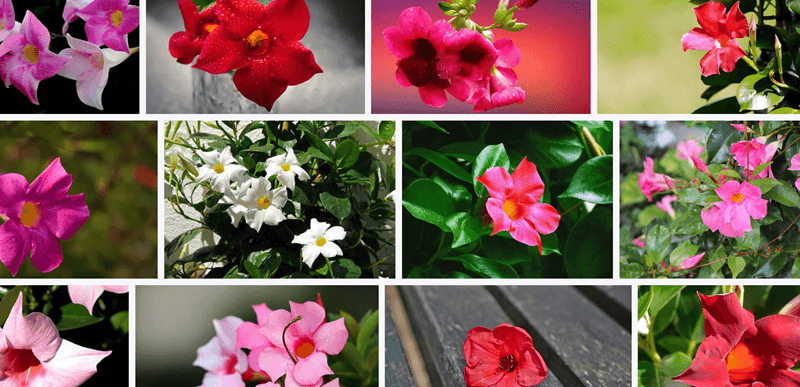Plant Care Instructions for Dipladenias, Dipladenia repotting, care tips, lighting, soil, watering, temperature tips.

Source : pixabay.com
Dipladenia (Dipladenia boliviensis, Dipladenia sanderi ‘Rosea’)
- Light: lots of light; no sun
- Temperature: 70° to 75° F – 21° to 24° C
- Humidity: 40%
- Soil: “potting” and black
- Watering: every third day
- Spraying: daily
A native of Brazil, this climbing plant with pink or white flowers is quite spectacular though, unfortunately, very sensitive. It needs a warm and moist atmosphere and a bright location. Make sure it is protected from direct sunlight. Since this plant needs a great deal of moisture you should spray it regularly with tepid water. Also place its pot inside a larger pot with good drainage.
Dipladenias will not flower in winter, so substantially reduce watering during that period. Continue fertilizing, but in slightly smaller amounts. For the resting period, the plant should also be put in a slightly cooler place. Propagation is achieved with slips. The cuttings will root in a sandy mixture. To prevent uncontrolled growth cut back your plant after it blooms. This is also the time for the annual repotting.
Grow a Dipladenia plant – Learn the difference between Dipladenia and Mandevilla
Tropical plants have a special place in my heart. My gardening area is not stifling, warm and humid, but it does not prevent me from buying a bougainvillea or other tropical plant for outdoor use. Plants thrive in summer but have to be moved indoors in the cooler season. Dipladenia, a favorite, is a South American native who grows in tropical forests. The plant is similar to the mandevilla vine and works outside in warm areas, or indoors as an indoor accent plant. We will discuss the difference between dipladenia and mandevilla so you can decide which of these amazing flowering vines is the best choice for your garden.
Mandevilla or Dipladenia
Dipladenia belongs to the Mandevilla family but has a decidedly different growth pattern. Mandevilla vines climb vertical structures to look for canopy light. Dipladenia is a thicker plant whose stems grow and hang.
The two plants have similar brightly colored flowers, but mandevilla has a larger flower typically in red. Both plants need the same bright light and the care of dipladenia is the same as for the vine mandevilla. When deciding between a mandevilla or dipladenia, the finest leaves and the smallest flowers in a wide range of colors can win the day for dipladenia.
Facts of Dipladenia
Dipladenia has a more complete form than the mandevilla. An important difference between dipladenia and mandevilla is the foliage. The leaves of dipladenia are thin and pointed, of an intense green color and slightly bright. The Mandevilla vine has larger leaves with a wider shape. The flowers are trumpet shaped and filled in shades of pink, white, yellow and red. The plants respond well to the pinching as they grow, which forces new shrub growth. Unlike the mandevilla, dipladenia does not emit so much growth upwards and does not need to be staked out.
One of the best facts about dipladenia is its ability to attract hummingbirds and bees. Tubular flowers are a vibrant signal for pollinators as great nectar providers.
Growing a Dipladenia plant
This plant requires warm temperatures for better performance. Nighttime temperatures should remain around 65 to 70 F. (18-21 C.). Water the plant frequently in the summer, but allow the first few inches of soil to dry before re-watering. The plant can go to the ground in warmer areas or remain in a pot.
The bright but indirect sun is a requirement to grow a dipladenia plant. The best flowers are formed in a well-lit area. Pinch of ungainly growth when the plant is young to force stronger and thicker branches. The only difference between mandevilla and care of dipladenia is that the mandevillas require a lattice or staking. Dipladenia only needs a stake to keep the small plant straight as it matures.
Fertilize every three or four weeks during the growing season with a liquid vegetable food as part of good care of dipladenia. To spend the winter in the interior or in a greenhouse and to suspend the fertilization in winter.
With a bit of luck, even gardeners from the north can keep the plant growing indoors until the summer heat arrives.